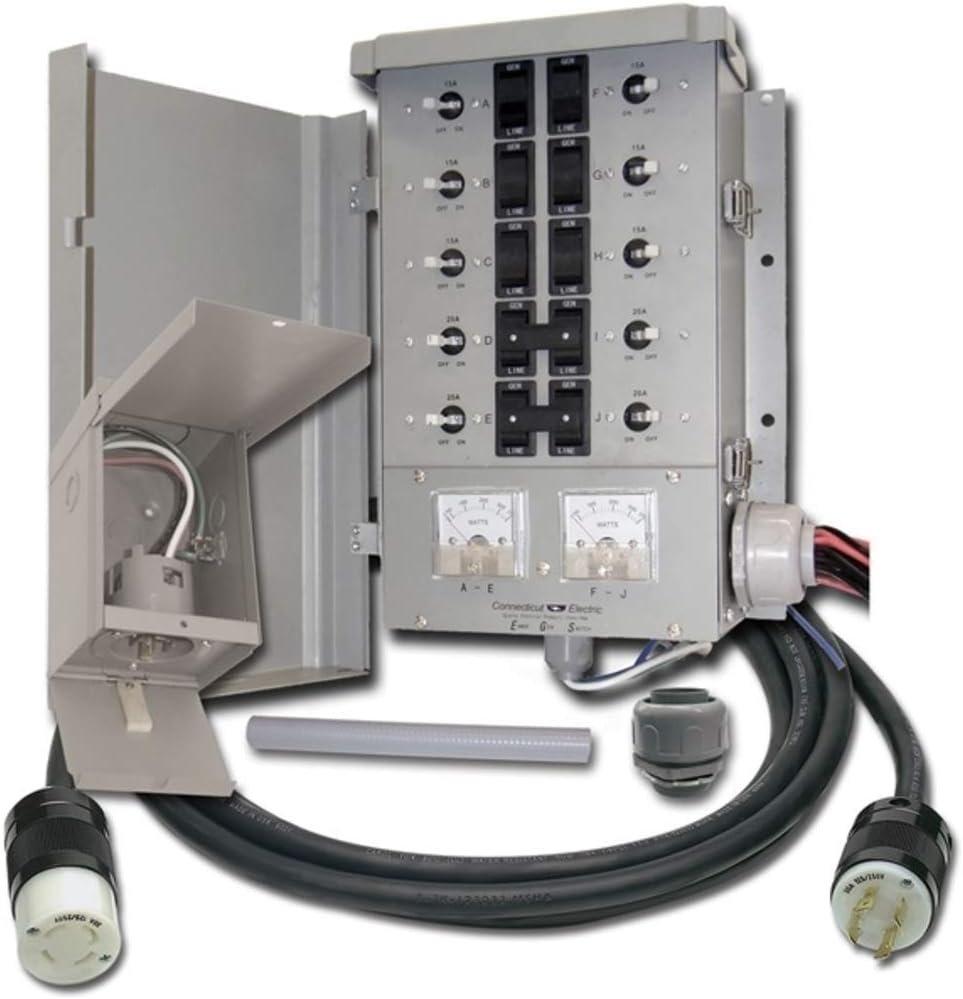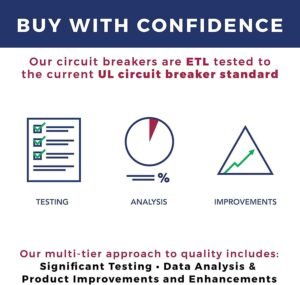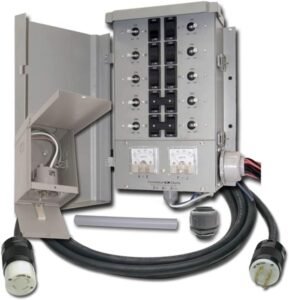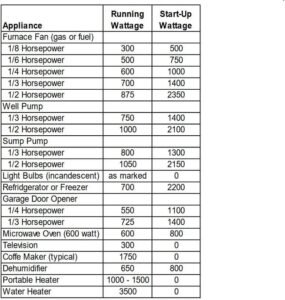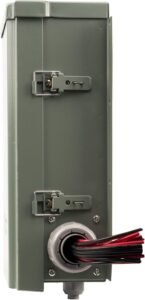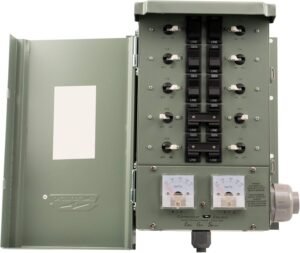Connecticut Electric EmerGen Transfer Switch Kit
Are you looking for a straightforward, budget-friendly way to connect a portable generator to your home’s circuits safely?
First impressions of the Connecticut Electric EmerGen Transfer Switch Kit
You’ll notice right away that the Connecticut Electric EmerGen Transfer Switch Kit – 30 Amp, 10-Circuit, 10-Foot Cord, 7500 Watts, for Generator is aimed at homeowners who want a plug-and-play solution for emergency power without the complexity or cost of a whole-house automatic transfer system. The kit feels solid and purpose-built for portable generator use, with a compact transfer switch and a matching power inlet that makes manual operation intuitive.
What the kit contains and why it matters
You get a transfer switch with 10 circuit positions, a 10-foot power inlet cord, and instructions. That combination matters because it lets you power multiple essential circuits while keeping your generator isolated from utility lines—reducing safety hazards and simplifying operation. The included cord length and NEMA L14-30 compatibility mean you can hook a typical 30-amp portable generator directly to the inlet without extra adapters.
Quick specification breakdown
You deserve a clear, easy-to-scan summary. Here’s a table that lays out the key specs and helps you compare at a glance.
| Feature | Specification | Why it matters to you |
|---|---|---|
| Model | Connecticut Electric EmerGen Transfer Switch Kit | Brand recognition and intended use |
| Generator compatibility | Up to 30 A, NEMA L14-30 | Matches common portable generators |
| Maximum wattage | 7500 W | Supports many critical home loads |
| Circuits | 10 positions (4 two-pole 240V, convertible to single-pole) | Flexible for pumps, HVAC, appliances, lights |
| Cord length | 10 ft | Direct hookup convenience |
| Enclosure rating | NEMA 3R (rainproof) | Suitable for indoor or outdoor mounting |
| Switch type | Double-throw rocker switches | Prevents back-feed to utility lines |
| Listing | ETL listed | Meets safety and UL standards |
| Compatibility | Fits major residential load centers | Works with most panels like Siemens, Square D, etc. |
How to read this table
You can use this table to quickly decide if the product meets your generator and circuit needs. If your generator has the L14-30 outlet and 30-amp output, this kit is an immediate candidate. The convertible circuit design means you can adapt it to your load preferences—helpful if you don’t need 240V circuits.
Design and build quality
The materials and layout are practical and no-nonsense. You’ll find the transfer switch enclosure is sturdy and resistant to weather, and the rocker switches have a tactile feel that inspires confidence when you switch loads manually. The power inlet is durable and designed for repeated plugging and unplugging, which matters in storm-prone situations where you’ll be using the kit repeatedly.
Durability and weather resistance
With a NEMA 3R rating, you can mount the inlet and most of the switch outdoors under cover. That means you don’t have to run long cords through windows or doors during an outage, which keeps things safer and cleaner. If you mount it outdoors, make sure it’s in a spot where water can’t accumulate directly in the enclosure.
Switches and wiring quality
The double-throw rocker switches reduce human error by clearly isolating generator power from utility power. The internal wiring is straightforward and uses common connectors, so if you’re comfortable with basic electrical work, you’ll find the wiring logical and clean. If you’re not comfortable, you’ll want to hire a licensed electrician to do the final connection to your panel.
Compatibility with generators and panels
You’ll appreciate the broad compatibility. The Connecticut Electric EmerGen Transfer Switch Kit works with most residential load centers (Challenger, Cutler Hammer, GE, Homeline, Siemens, Square D, Westinghouse), and the L14-30 inlet is standard for many portable generators up to 30 amps. This compatibility simplifies a lot of the guesswork when you’re shopping.
Using the 240V circuits and conversion option
Four of the circuits are configured as 2-pole 240V circuits out of the box—ideal for pumps or other heavy loads. If you don’t need 240V capacity, the tie bars that create the 240V connections are removable, converting those positions into additional single-pole circuits. That flexibility lets you target either larger appliances or a larger number of smaller circuits, depending on what’s most important to your household.
Installation overview (what you should expect)
You’ll find the installation process fairly accessible if you have some electrical experience. The kit includes instructions and is designed for relatively straightforward mounting and wiring. However, because you’ll be working with your main electrical panel, you should carefully assess your comfort level and local code requirements before proceeding.
Tools and supplies you’ll need
You should have basic tools on hand: screwdriver set, wire strippers, voltage tester, drill, and appropriate safety gear. You may also need additional wire, conduit, and connectors depending on the distance between the inlet and your load center. If you’re not certain about the wire size or connections, consult a licensed electrician to avoid safety or code issues.
Step-by-step highlights
- Choose a mounting location for the inlet that’s accessible and protected.
- Mount the transfer switch next to your existing load center (or in an approved position) and identify the circuits you plan to transfer.
- Shut off the main breaker before making any panel connections.
- Connect the transfer switch to the selected breakers using the provided instructions and ensure proper wire sizing.
- Install the power inlet and connect to the transfer switch wiring; test the connections with the generator before an emergency.
Under a qualified electrician’s guidance, you can have this kit installed and tested in a few hours. If you try this yourself, double- and triple-check your work—this is a safety-critical installation.
Safety features and regulatory compliance
You’ll find multiple safety features that help protect you, your generator, and utility workers. The double-throw switches prevent back-feeding, and the ETL listing provides assurance that the product meets recognized safety standards. These features are critical because improper generator connection can injure utility workers or damage equipment.
Back-feed prevention
The transfer mechanism ensures that when you switch to generator power, the utility feed is mechanically disconnected. That eliminates the possibility of powering the grid from your generator and keeps your responsibility limited to your own circuits.
ETL listing and why it matters
ETL listing shows the kit has been tested to meet applicable safety standards. You should still comply with local electrical codes and permit requirements, but ETL gives you a higher confidence level in the product’s electrical safety and construction.
Capacity and load planning (what you should consider)
You want to make the most of the 7500-watt capacity while not overloading your generator. The kit’s 30-amp limit translates to practical constraints on what you can operate simultaneously. Planning your loads will prevent nuisance trips and ensure critical systems stay running.
How to prioritize your circuits
List your essential circuits (refrigerator, furnace blower, well pump, sump pump, a few lights, medical devices, etc.) and calculate their starting and running watts. Some motors, like pumps or HVAC compressors, have high starting draws that briefly spike beyond running watts, so account for that. You’ll often power these motor loads one at a time or use a generator with enough headroom to handle the startup surge.
Example load scenarios
- Basic scenario: Refrigerator (800 W running), a few lights (200 W), modem/router (50 W) = ~1,050 W running — easily within capacity.
- Moderate scenario: Refrigerator, furnace fan, well pump (startup surge), lights, TV = plan for 3,000–4,500 W depending on motor start loads.
- High-demand scenario: Electric range, electric dryer, central AC = typically exceeds the 7,500 W limit and should be avoided on this kit.
If you’re unsure, map out wattage for each circuit and prioritize automatically or manually switching off less critical loads to avoid overload.
Practical use cases
You’ll see a lot of value if you have a well pump, sump pump, essential refrigeration, or a medical device. The option to keep 240V circuits for pumps is particularly useful in rural or storm-prone homes. The kit’s compactness also makes it a solid choice for seasonal homes where you want a reliable temporary setup.
Ideal homeowners for this kit
- Those with portable generators up to 30A who want a safer way to power essential circuits.
- Homeowners with well pumps or sump pumps who need 240V transfer capability.
- People who want something simpler and less expensive than an automatic transfer switch.
Less ideal situations
- Homes relying on whole-house electric loads including central AC and electric ranges—those exceed the kit’s 7500 W capacity.
- You’ll want an automatic transfer switch for unstaffed operations where automatic switching is critical (medical facilities, continuous care needs).
Installation tips and common pitfalls
You’ll save time and reduce risk by following a few practical tips. Like any electrical project, planning and attention to detail make the difference between a smooth installation and frequent headaches.
Tips for a smooth install
- Pre-label the circuits in your panel and determine which breakers you’ll move to the transfer switch.
- Use the shortest, most direct route for wiring to reduce voltage drop.
- Ensure wire gauge matches the load and breaker sizes; undersized wire is a hazard.
- Test your generator under load before you need it in an actual outage.
Common mistakes to avoid
- Forgetting to secure permits or follow local codes—this can be costly and unsafe.
- Underestimating motor starting currents, which can trip breakers unexpectedly.
- Mounting the inlet in a location that permits water pooling—avoid low points and direct runoff.
Troubleshooting and maintenance
You’ll want to perform basic maintenance and know the common trouble signs to keep the kit dependable for emergencies.
Routine checks you should perform
- Inspect the inlet, cord, and enclosure for physical damage or corrosion at least annually.
- Cycle the switches periodically to ensure they operate smoothly and haven’t seized from lack of use.
- Test the setup under generator power to validate load distribution and correct wiring.
Common problems and fixes
- Intermittent generator connection: check cord and inlet for broken pins or corrosion.
- Nuisance breaker trips: isolate high-starting loads and stagger their startup.
- Switch resistance or heating: ensure tight connections and correct torque on lugs; call an electrician if terminals are hot.
Comparisons to alternatives
You’ll want to know how this manual transfer kit stacks up against other options: subpanel setups, automatic transfer switches (ATS), and simple extension cord connections.
Manual transfer switch vs. direct extension cords
Using the EmerGen kit is far safer than running extension cords from a generator into your home. The kit isolates circuits and prevents back-feed. Extension cords are a higher-risk option and are not a safe substitute for a transfer switch.
Manual transfer switch vs. automatic transfer switch
An ATS provides automatic changeover when grid power fails, which is ideal for unattended homes or critical medical equipment. The Connecticut Electric kit is manual, meaning you’ll have to be present to switch loads. The manual system is typically lower cost and simpler to install, making it an attractive option for many homeowners.
Manual transfer switch vs. whole-house interlock or subpanel
A professionally installed whole-house solution can provide more seamless coverage but costs more and usually requires a higher-capacity generator. This kit is a middle-ground: more organized and safer than ad-hoc methods, more affordable and simpler than full automation.
Code, permits, and professional installation
You should check local codes and obtain any necessary permits before installation. Many jurisdictions require a licensed electrician to make permanent connections to the service panel. Even if you’re comfortable with DIY wiring, a permit inspection helps ensure your setup is safe and legal.
What to expect from an electrician
A licensed electrician will verify wire sizes, torque connections, and ensure the transfer switch is installed per national and local codes. They’ll also help you identify the best circuits to include and confirm that the generator’s output matches the kit’s limitations.
Paperwork and inspection
You’ll likely need to show the electrician or inspector the transfer switch manual and product listing (ETL). Keep copies of receipts and installation documentation for future reference and to maintain home safety records.
Accessories and optional upgrades
You may want to add a few accessories to make operation easier and more reliable.
Useful add-ons
- Weatherproof cover or small awning for the inlet if mounted outdoors.
- A longer or higher-quality generator cord if the 10-foot length doesn’t reach comfortably.
- A portable transfer switch locking mechanism or padlock for added security.
Generator considerations
If you plan to upgrade your generator later, make sure its receptacle matches the L14-30 or that you have safe adapters. If you might need more than 7,500 watts in the future, consider a higher-capacity transfer switch and generator pairing.
Pros and cons — a summary you can use to decide
You deserve a clear summary to weigh the trade-offs.
Pros
- Affordable and straightforward installation for many homeowners.
- 10-circuit capacity with convertible 240V circuits adds flexibility.
- ETL-listed and NEMA 3R rated for added safety and outdoor use.
- Double-throw switches prevent dangerous back-feed.
- Compatible with most residential load centers.
Cons
- Manual operation requires you to be present to switch loads.
- 30-amp limit and 7,500-watt capacity can be limiting for whole-house needs.
- Installation touches the main panel, so permits and electrician involvement may be required.
Real-world performance and usability
In everyday use, the kit performs exactly as advertised: reliable, user-friendly, and robust enough for seasonal or emergency use. You’ll appreciate the straightforward toggling of switches when power goes out and the peace of mind that comes from not back-feeding the grid.
User feedback trends
Owners generally report satisfaction with the build quality and functionality. Complaints, when they occur, are usually about underestimating load requirements or improper installation—both preventable with planning or professional help.
Frequently asked questions (FAQs)
You’ll likely have a few questions. Here are common ones and clear answers so you can decide confidently.
Can this kit be used with any generator?
Yes, as long as your generator provides a standard NEMA L14-30 outlet and has an output within the 30A, 7,500W limit. Always check starting and running wattage for motor loads.
Can I power 240V appliances?
Yes, the kit includes four 2-pole 240-volt circuits. If you don’t need 240V, you can remove tie bars to turn those into single-pole circuits.
Is this safe for outdoor installation?
Yes, the transfer switch and inlet are NEMA 3R rated, meaning they’re suitable for outdoor or indoor mounting in rain-prone areas when installed as directed.
Do I need an electrician?
You should consult local codes, but because the kit interfaces with your main electrical panel, many areas will require a licensed electrician for final hookup. If you’re experienced and permitted to work on your panel, you can install it yourself while following local codes.
Final recommendations — is this the right choice for you?
If you want a cost-effective, safe, and flexible way to power essential circuits from a portable generator, the Connecticut Electric EmerGen Transfer Switch Kit – 30 Amp, 10-Circuit, 10-Foot Cord, 7500 Watts, for Generator is an excellent choice. It balances affordability with safety and includes features that cover the needs of many homeowners.
You should choose this kit if:
- You own a 30A portable generator with a NEMA L14-30 outlet.
- You need to power specific essential circuits, especially pumps or a few high-priority loads.
- You want a safer solution than extension cords but don’t need automatic switching.
If you require automatic transfer, whole-house coverage, or greater wattage, you’ll be better served by higher-capacity equipment and an automatic transfer solution. For most residential emergency setups, though, this kit provides an excellent blend of functionality, safety, and value.
If you want, I can help you map which circuits in your panel make the most sense to connect to this transfer switch, or walk you through a sample load calculation based on the specific appliances you want to power.
Disclosure: As an Amazon Associate, I earn from qualifying purchases.
